Filed under: Action, Anarchist Movement, Community Organizing, Featured, Immigration, Midwest, Solidarity
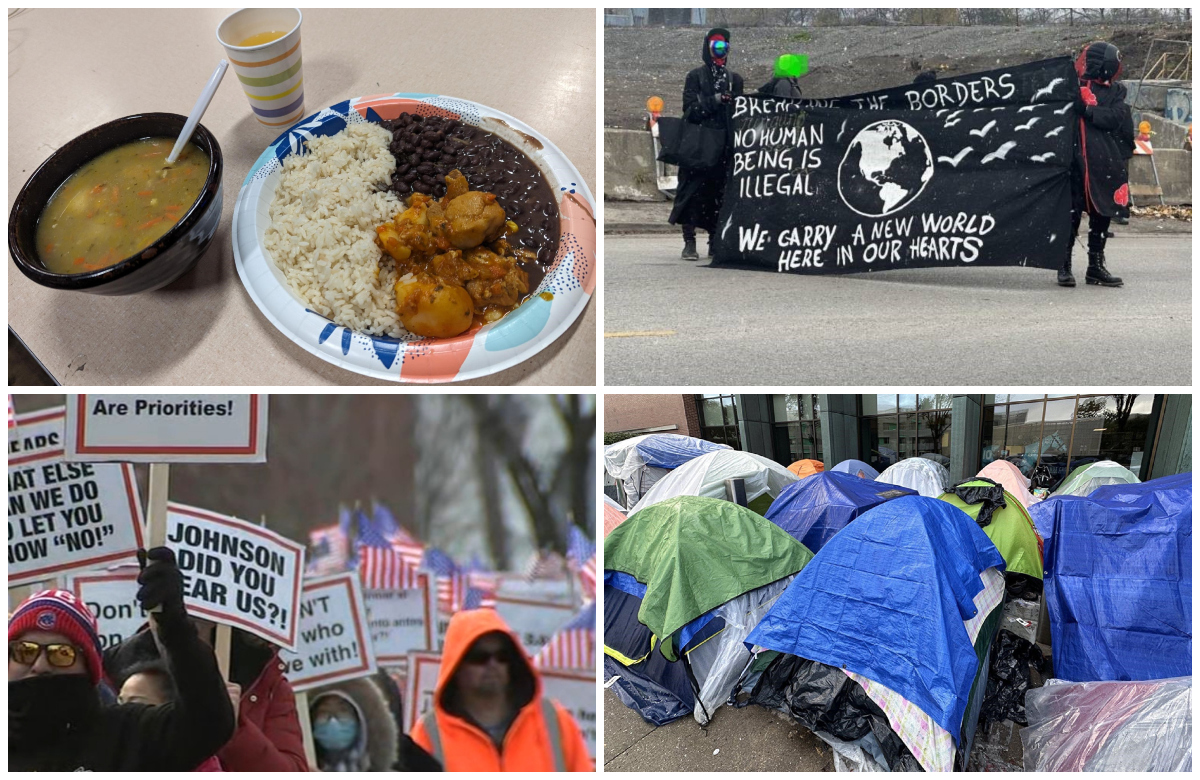
A critical report, reflection, and analysis on anarchist organizing in Chicago, IL in solidarity with migrants, largely from Venezuela.
A deepening economic crisis resulting from U.S. sanctions, colonial extractivism, and inter-imperial disputes has been fueling forced migration north from Venezuela. Since August 2022, governors of US border states, especially Texas, have spent lavishly on corralling and shipping migrants seeking asylum to northern Democratic-party strongholds, a program explicitly targeted at gaining leverage in the spectacle of two party politics. More than 26,100 migrants, the vast majority from Venezuela, have been shipped to Chicago since 2022. As of January 2024, over 600 migrant busses have arrived in Chicago as well as several chartered planes. Busses continue to arrive every day and more recently the drivers have began dropping people outside of the designated intake location and even outside of the city altogether, leaving people in random parking lots with no information, no winter clothes, no food and no water.
Part 1. Manufactured Crisis
Once in Chicago, the migrants face a third manufactured crisis: the logistics of warehousing and relocation built over two successive “progressive” democratic administrations – first Lori Lightfoot and now Brandon Johnson. This involves several stages of containment, processing and relocation across distinct tiers of carceral facilities rebranded by the city as shelters. Migrants are initially taken to the so-called Landing Zone downtown for processing, where they wait for days before being shipped to police districts or airports, designated as initial influx shelters. Here, they wait by the hundreds, surviving for weeks or months either on the floors inside or in tents outside the facilities, until they are again picked up en masse and relocated to a second tier of so-called shelters. Many of these are vacant industrial warehouses, where between 2,000-3,000 people are held under toxic environmental conditions, an extreme lack of hygiene access and strict regimes of surveillance and control.

Tent encampment outside of police station.
As of January 2024, official figures report more than 15,000 migrants still living in these shelters. The city government had imposed a 60-day limit on shelter stays for all migrants entering the city after the 17th of November, meaning that the first wave of enforced evictions was scheduled for January 18. However, as of the release of this article, the city has postponed this eviction date due to extreme low temperatures and media fallout after the death of a young child from one of these facilities, Jean Carlos Martinez Rivero, age five. The new eviction date is February 1st.
Part 2. The Deepest Economic Contraction in the Americas
The manufacturing of Venezuela’s collapse has provoked the largest displacement of people in the history of the Western hemisphere. Conditions have worsened so dramatically in the last five years that a quarter of all Venezuelans have decided to leave the country. For many refugees it has been impossible to afford basic necessities or even find them due to supply shortages. What many have called ‘the deepest economic contraction of a national economy in the Americas’, might be more accurately described as the faltering of an ecocidal machine built on oil and external debt – pushed off the precipice by the U.S. government and its multiple attempted coups.
Nonetheless, Venezuela continues to operate as a frontier for the expansion of extractive capitalism and the liquidation of indigenous territories at the behest of multinational corporations and foreign creditors. Now, the country is threatening military action against Guyana over control of the oil-rich region of Esequibo, and auctioning off its state-owned refineries abroad. The situation only seems to be getting worse. It is in this bleak context that many have embarked on long journeys across the continent, surviving the Darien Gap, paramilitary violence, gangs, narcos, human traffickers, trains, military check points, police mordidas and more, only to arrive to “sanctuary” characterized by extreme dehumanization and constant surveillance; their survival made into a pissing contest between governors and a spectacle of suffering for the media.
As the effects of this crisis progress in Chicago, we are finding it increasingly important to deepen our analysis of the political motivations behind fabricated resource crises particularly as they relate to all non-white / non-European immigrants, and the goals that such narratives serve. The already existing rhetoric surrounding immigration from central and South America, concurrent with the visibility of the city’s solutions of povertized and carceral shelter has fueled xenophobic attitudes and fears rooted in hegemonic nationalism and a deep internalization of resource scarcity. While we ultimately seek to dethrone anything that comes close to civilization’s concept of and relation to “resources” or “resource management”, we also need to locate and dispel it’s “lack of resource” crises within an empirical arsenal of tools meant to prevent an intercultural, interracial, inter-generational solidarity that is threatening to state power.
Part 3. Houses Not Camps / Casas No Carpas!
This fall, Chicago’s liberal mayor signed a $29 million contract with Gardaworld, a transnational private security corporation, with plans to build enormous barbed wire fenced winter base camps and hold migrants there through the sub-freezing winter. People would be stuffed in soft tents rated to only 40°F (pg. 101 of contract) and forced to abide by rules and curfews, with the flow of people and resources managed by a military contractor.
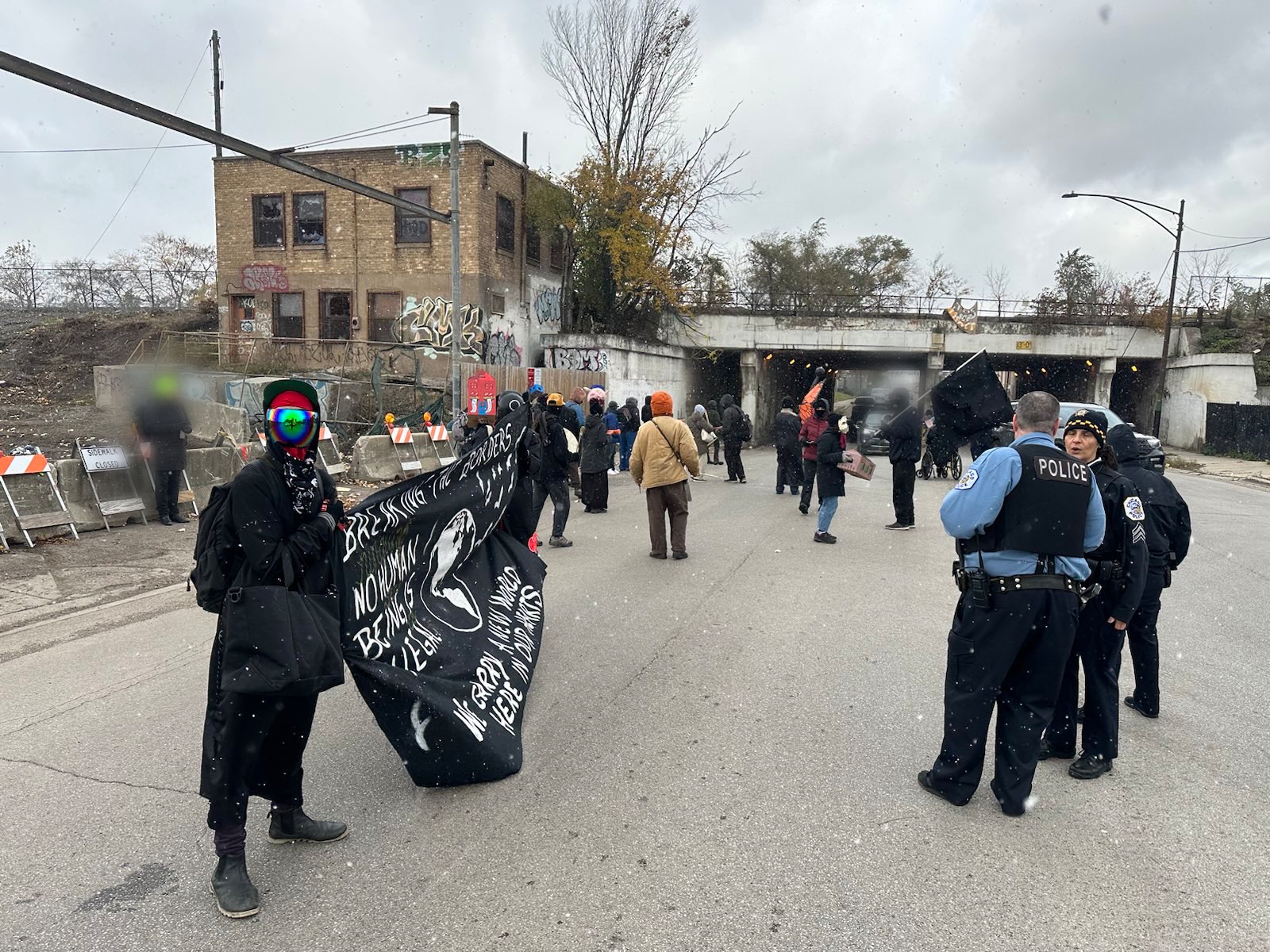
Anarchist responses to this so far have consisted of several street demos, strategy sessions, a ton of research, lawsuits, FOIA-ing, compiling of information about GardaWorld’s other “shelter” operations, extensive self-organized autonomous mutual aid projects, and possibly some well aimed graffiti.
The images seen here are from a scrappy but energetic Halloween march which blocked traffic for a while in front of one of the proposed Gardaworld basecamp sites. That particular project has since been cancelled due to dangerous levels of toxins and insufficient soil sampling; concerns by local environmental justice groups having been raised only after a significant foundation of resistance had been laid by anarchists across the city. The trashing of the project likely came about more as a result of the research, FOIA’s, and strategic pushing of an anti-carceral stance than to this particular street performance, but either way it was a splendid afternoon spent in costume that brought us together in the streets and certainly lifted our spirits!
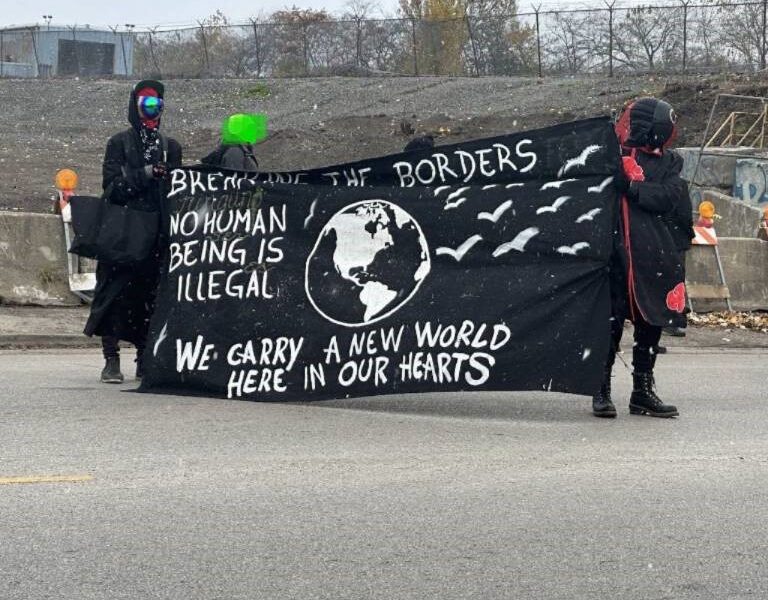
Our chants of “casas, no carpas” reached the ears of many neighbors, challenging the Gardaworld tent city solution on the basis of it’s fucked up, thus simultaneously challenging the eruption of local xenophobic sentiment which has also sprung up in the neighborhood. A new anti-immigrant group had organized itself into a strong opposition to the camp proposal, staging an ongoing presence and blockade at the tent construction site featuring signs reading: “WE Live Here, YOU Don’t,” “Send Them Back,” “Save Our Community!,” and many more.
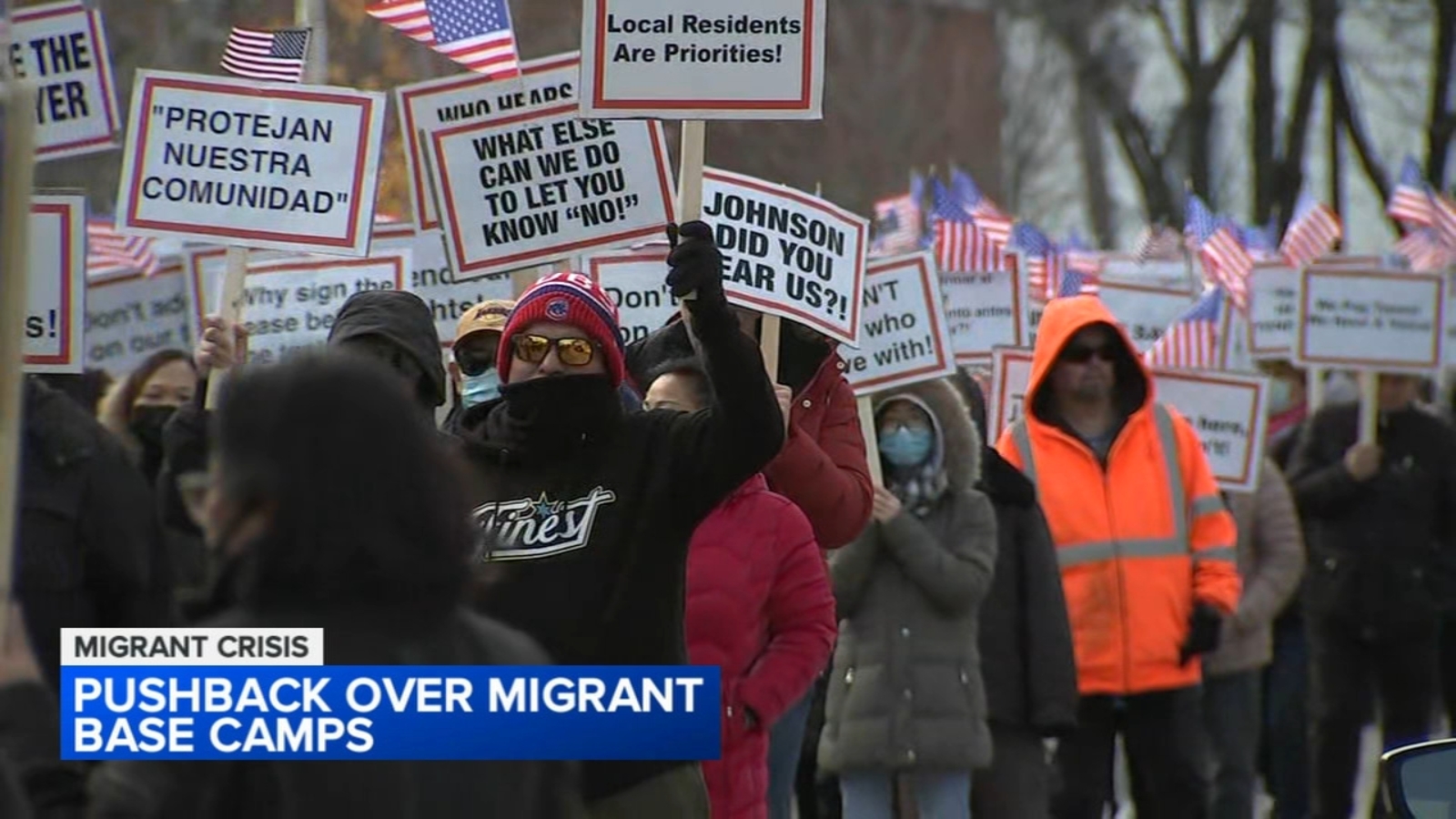
Since the organizing, framing and staging of this action was supported by several weeks of mass flyering and tactical interventions at other explosive gatherings in the neighborhood, we were already well aware of this group and not at all surprised to find ourselves in an intersection of confrontation with them.
Part 4. Anarchist Skillshare and Migrant Solidarity Gathering Reportback
In part as a direct response to all of this, but also as the obvious result of a culmination of existing intentions, long-term organizing and organic shifts in the scene, the skillshare this fall focused on strengthening and re-imagining Chicagoland solidarity networks on the basis of intersectional struggles against incarceration and the criminalization of free movement. In 2 packed days of workshops, discussion, smoke breaks, a movie night slumber party, a show, multiple street actions, and food everywhere in between, many connections were made and existing ties tightened. A highlight reel of workshop topics that were explored include: surveillance and operational technology, ongoing community jail support, “shelter” as carceral politic, prison censorship and state repression, and solidarity across borders. This was the 5th anarchist skillshare held in a year and a half – sorry it’s the first reportback, but let’s make up for it by offering some reflection.
Every past skillshare had produced feedback and reflection on the desire for less exclusivity, for more direct involvement from people we don’t already know/work with. The question arose (and not for the first time): how do we actually do that? How do we change the space to allow for more collaboration? How do we break out of the insular nature of a scene without foregoing the necessary levels of trust, security and commonality? Maybe it comes down to a question of anarchism itself: whether or not it can let go of it’s own self-imposed limitations to allow itself to become what many of us actually want from it – messiness, growth, experimentation, multiplicity. And how do we move towards that?
Certainly the paths are many. One step we took this time around was to open up the actual planning process. It felt important to do things really differently this time, but to do it in a way that wasn’t going to compromise our existing goals, needs or the work we’d already done. So with the nuts and bolts of the event already in place we hosted a public potluck and planning meeting, inviting others to fill in the empty spaces intentionally left in the schedule. We knew there were tons of other people fighting for abolition, tons of other people trying to figure out how to respond in solidarity with new asylum seekers, and many already taking action, so in creating space for a larger conversation we were able to 1. get a better idea of what was already happening and what needed to be happening, 2. meet more people with common struggles and commitments/ vibe each other out, and 3. bring new people with shared dreams of abolition into autonomous spaces and modes of organizing. Conversely, over the past few months more anarchists have moved themselves into non-anarchist spaces/responses; keeping a close eye on lib chats, engaging more with non-politicized mutual aid groups and firing them up, pushing far more critical stances and inserting antagonisms when there are none.
Part 5. Occupying the Social Center and Un Comedor Nuevo
Simultaneously, in the weeks leading up to the gathering, some of us had been connecting with asylum seekers staying at the police station down the street from the social center where the planning events and skillshare itself would be hosted. A series of community meals, food distribution efforts and clothing drop-offs, at first spontaneous and quickly increasingly planned, lead to two intentional meetings with a group of self-organized migrants (mostly women), who had been working together to equitably distribute donations and mediate conflicts in their spaces. They immediately started using the social center to cook biweekly large-scale meals for everyone at the nearby encampment and organized all the donations into a free store. The group was invited to speak at the skillshare where they shared their experiences and analysis of the horrible conditions in the so-called shelters, the threats and repression which met any attempt to record or document these conditions, and elaborated on some of the intensely gendered power and resource dynamics they had been navigating with the men in their communities.
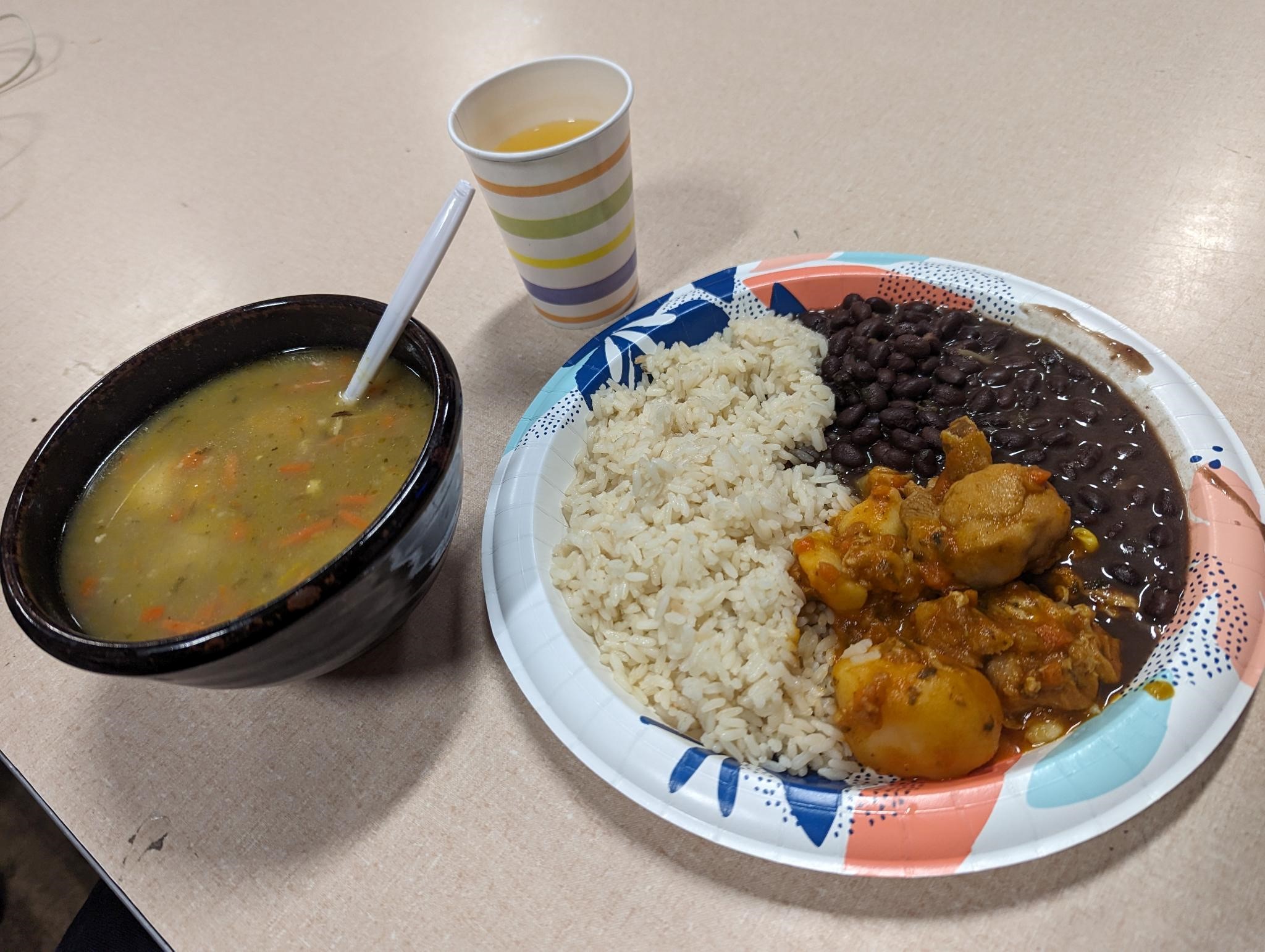
Just one of the thousands of delicious multi-course meals that have been served at the comedor since October.
Incidentally, the skillshare/migrant solidarity gathering coincided directly with an illegal lockout and attempted eviction of the social center. With all this new energy for the space, and the momentum of the upcoming gathering, some people were able to come together and within hours execute a plan to begin squatting the social center to maintain access for both these and other projects. Three months later, we are still holding on; new projects are starting up in the space, and we are getting better at planning ahead and taking care of each other. The migrant group organizing the comedor has grown and is continuing the project as well as actively participating in caring for and defending the space.
The fact that this group – none of which ID as anarchists – has been actively involved in shaping the social center’s evolving needs and determining it’s capacity, has created a fertile ground for moments where really new possibilities and relationships rise up through shared life and struggle – not ideology. And of course there have been ideological challenges through all of this – as well as social, political, cultural, legal and more, but overall this web of experiments has been hugely successful and the risks we have all taken shaped not only a great deal of the fall skillshare, but also the coalescence and endurance of these really powerful longer term projects.
Part 6. A Call to Action / A Call to Light
We feel that consistent public or semi-public anarchist projects and events on a local scale are extremely important because visibility opens things up to reflection, collaboration and metamorphosis. We don’t want to see anarchist worlds retreat entirely from a public sphere of life. If everyone who is dedicated to unwavering anti-authoritarian methods of struggle is trying to be invisible, where does that leave us in our ever unpopular struggle for a different world? We are under no delusions of authoritarian grandeur that we might convert “the masses” (even if we wanted to), rather, we honor the necessity of growth-death-change in the survival of any organism or ecosystem and our experience is that anarchists like other living things need both the shadows and the light. This is not to say there aren’t things that must only be done in the shadows, but to offer an example of a time and context in which more visibility worked for us and our goals, in hopes that it might inspire others to take similar risks. Our goal was and is to move away from both the general barriers of exclusivity often found within anarchism, as well as our original form as a convergence of randomly submitted workshops, towards becoming an effective part of the long term social fabric of resistance in Chicago.
We live in a time of ceaselessness; of endlessly compounding crises, the horror and gravity of which threatens to overwhelm and immobilize any real attempts at resistance. But this moment of heightened social and political tension presents many possible points of rupture with the existent world, and is itself a call to double down on actions that counter the isolation and fear that the logics of empire ruthlessly impose. Moments like this provide endless opportunities to further expose these truths and deepen the cracks in the façade. We must refuse to be afraid of each other and ourselves, refuse to let the professional co-optation of solidarity models keep us from enacting our own, refuse to be robbed of agency and imagination, refuse to keep only to the shadows!
From Chicago to Venezuela to Palestine to the Congo, resistimos !





